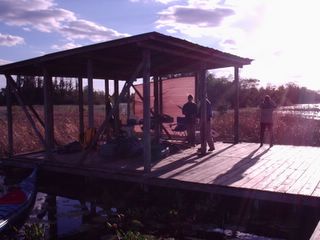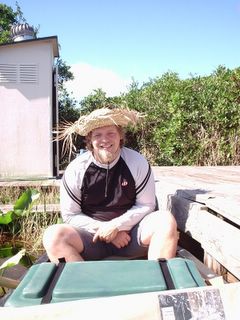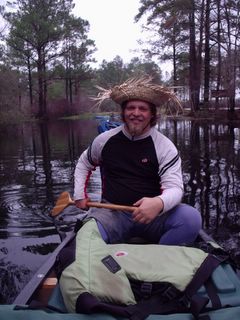Some of the same storms that gave us so much excitement in the Okefenokee meant the Plateau was cranking when we got back to Nashville. Lucas headed west for the Buffalo River in Arkansas, but I stayed in town to get caught back up with work. A pleasant consequence of that meant I got to paddle the West Fork again. The last time I paddled it was in December 2002. It was my last real whitewater paddle before my hiatus for school. I remembered two rapids from it. One had a big boulder in the middle. I remember screaming and then avoiding the big boulder. The other had an even bigger boulder in the middle and I remember catching the eddy behind it and then sneaking the rest of the rapid on far left. This time the water was much higher and it promised to be a different run.
The weather didn't look so promising for Saturday, so when Woody called to say they would run it on Sunday when the weather was promising to be much warmer, my decision was made. When Woody said the official TSRA trip would involve a group of boy scouts as well as the TSRA paddlers, my decision was reinforced. Diann said the run would be one big wave train.
On Sunday, Diann, Woody, Bob, Jean, Morris and I met at the Cookeville Cracker Barrel for breakfast and then we headed to the put-in. Diann had said the run would be one big wave train. She was almost right. It was one big drunken wave train, with cross currents making it a bit more turbulent and unpredictable than the bouncy wave trains on rivers like the Nantahala.
Since Lucas was away, I got to pack all of my usual gear into just my kayak. The result was a bit heavier boat than I'm used to paddling. It tracked really well. I was able to surf across one of the waves just below the put-in bridge with very little effort.
The first few rapids were fun bouncy waves. Unfortunately, maybe three rapids in, I had a little bit of a scare not too far from the put in. The waves made for a really strange but tenacious eddy line. I tried several times to catch either of the eddies, but couldn't get off the river left eddy line. The remains of what looked like a footbridge were dangling in the river. It was sort of like barbed wire and I was washing toward it out of control. One end was attached high on the river left cliff. The other end was clinging to the remains of a couple of dead trees on river right. Most was hanging at or very close to the main channel. Sneaks were available on river left and river right. I barely made the river left sneak and finally broke free of the eddy line to catch an eddy below me. I was definitely unnerved.
Not too long after that incident, we came to the first rapid that I remembered from the 2002 trip. I got out with Diann and Woody to scout. It looked nothing like the rapid I remembered. The water was much higher and the big boulder in the middle was gone. I didn't like the looks of the river left holes. They looked big, with sharp, pointy teeth and bad breath. Probably I could have made the moves to avoid them, but the lingering out of control feeling from the near barbed wire encounter was still with me. I decided to walk the first half and get back in where I knew I wouldn't have any difficulties. Diann and Woody chose to bounce through some rocks on river right to avoid the big stuff. Diann met up with me in the eddy and said it was plenty easy and I should have tried their route. Nerves are nerves, though. I gradually worked them out of my system as the run progressed.
The rest of the intimidating rapid was big bouncy fun. More fun bouncy stuff followed. Occasional waterfalls enhanced the already lush scenery, with flows ranging from a trickle to an overwhelming gush. One of the waterfalls came raging in from river right in one of the more fun bouncy rapids. The waterfall extended about a quarter of the way into the channel. The awe distracted me from my line, but I made a quick recovery to get where I needed to be.
Soon we arrived at the second of the rapids I remembered. Big Mama. With the high water, she was a much different woman from what I remembered her to be. The big boulders were the same, except this time the undercuts were filled with wood. The far left line that some remembered looked like a terrible idea. Sneaking between a barely submerged rock within probably inches of an undercut? Somebody else can try that move. I decided to tangle with Big Mama head on.
We scouted from the eddies behind the two big boulders on river right. The main channel was running between those boulders and the big boulder in the middle of the channel. Bob and Jean and Morris caught the eddy behind that big boulder and were waiting for us to get there. Diann went first, attempting to ferry directly across the channel. The river said no and she ended up running the rocky boogie water to the bottom of the rapid. She eddied out at the bottom looking like she meant to go that way. Woody followed her, leaving me in the eddy to either make the ferry or tangle with the last part of the rapid.
I decided to try for the ferry, but start out much higher so I'd have more time to work left and choose my entrance to the eddy. I ferried into a peelout and worked left pretty easily. The entrance of the eddy looked painfully rocky so I had to catch the eddy pretty low. It felt a bit like an accelerator as I began the eddy turn. Like I had practiced in the Winter Clinic, I fixed my eyes on Morris in the eddy and leaned hard as I crossed the eddy line. And screamed. And turned. And there I was. In the eddy. Upright. Knees knocking. It worked. I didn't really wait for the adrenaline to die down. I finished the rapid by taking the sneak route on river left. I caught an eddy at the bottom and ferried over to meet up with Diann and Woody at the lunch rock. The rest of the group finished running/playing the rapid and joined us.
After lunch, we ferried back to river left and took a short hike to see some waterfalls. One was dry. The rock outcropping was still pretty cool. It reminded me of the Natural Bridge at the fat farm where we put in Fortyeight Creek, except without the bridge part. The other waterfall was a cascade down a rock face. The moss growing in the rock crevices spread the water out as it fell, making it look like the water was rinsing shampoo away. Along the hike to and from the waterfalls, we admired the white and purple trillium that was just beginning to bloom.
The remaining paddle out was nowhere near the difficulty of Big Mama. The river gets tamed as it flows toward the lake. There were plenty more wave train rapids to enjoy and several more cascading waterfalls. We saw a hawk circling above, or at least a very pretty buzzard. Bob found a tree frog hanging out on a tree near the river.
Soon the takeout bridge was in sight. As we got out of our boats and prepared to carry everything to our vehicles above, we checked the water level. The bridge gauge read just a hair over 4' when we took out. Future reference, 4' is a really fun level to run the West Fork.
Morris had run our shuttle in the morning, so we brought him and his gear back to the top, enjoying the last of the gorgeously sunny weather before saying our goodbyes and heading for home.















